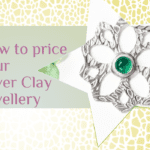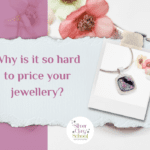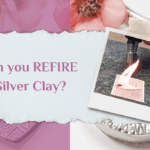Different Types of Silver Clay explained
I was teaching this weekend and as I always do, I was chatting to my students before we got down to the nitty gritty of making beautiful jewellery with silver clay. And one thing that came out loud and clear was the confusing array of silver clay varieties in the market place today and the need to have the different types of silver clay explained.
And I get it. When I started on my silver clay journey there was *cough* only one type of silver clay available and two manufacturers. A bit like the famous cola varieties out there – two companies making basically the same product.
But not anymore.
There are a lot more varieties of silver clay out there and there are a number of new suppliers too. And it’s confusing, don’t you think? When you are ploughing through the internet trying to find as much information as you can and just getting more and more confused as a result?
So, I thought I would create a wee blog to give you the heads up. And if you want a more in depth description of silver, the types and varieties of silver clay and who makes them, then please download my FREE Beginner’s Guide to Silver Clay which is a great reference document for you – link at the bottom of the post
Another thing to say to you – it is worth shopping around for silver clay as there can be quite a large difference in price between the better-known clay brands such as PMC and ACS and the lesser known ones like Aussie Metal Clay and FYI.
If you are importing from another country, you will need to take into account exchange rates, shipping costs and possible tax charges applied when the package arrives in your country.
Fine Silver Clay
This is the original one that was first to market. Fine silver is the purest form of silver you can get as in 99% silver and it is softer than other silver varieties.
PMC3 by Mitsubishi
This is a fine silver clay widely available. It can be fired by hand using a torch or it can be fired in a kiln. UK supplier – www.pmcshop.co.uk US supplier – www.riogrande.com
ACS by Aida
This is a fine silver clay widely available. It can be fired by hand using a torch or it can be fired in a kiln.
UK supplier – www.metalclayltd.co.uk US supplier – www.artclayworld.com
Aussie Metal Clay .999
This is a fine silver clay, not as widely available as PMC and ACS, but they do have distributors outside of Australia, although some distributors may not supply the silver clays.
This fine silver clay must be fired in a kiln.
Global supplier – www.aussiemetalclay.com
Metal Magic Silver Clay
This is a fine silver clay, only available from one outlet in the US. This clay must be fired in a kiln.
Global supplier – www.metalclays.com
FYI Silver Metal Clay
This is a fine silver clay. Sold on Etsy for anyone in the UK and Europe. If you’re in the US, you can visit Metal Clays.
Sterling Silver Clay
Sterling silver, is perhaps the most recognisable type of silver in the market place. But what you may not realise is that sterling silver is an alloy of silver and copper. To be precise it’s 925 parts silver and 75 parts copper. Making a commercially available sterling silver clay was once, considered to be impossible but thanks to Lisa Cain’s successful experimentations combining copper clay and fine silver clay – Mitsubishi were convinced it could be done. Their Sterling Silver PMC was launched in 2011. To date, it is the only true Sterling silver clay out there – more on that in a minute.
Sterling silver clay needs to be fired in a kiln and it needs a two-stage firing process. The first stage is to fire on an open shelf to burn away the binder. The second stage has to be in a firing pan, submerged with carbon.
Sterling silver clay is the strongest silver clay on the market because of the additional copper content. But the firing process did put a lot of people off.
UK supplier – www.pmcshop.co.uk US supplier – www.riogrande.com
Enriched Fine Silver Clay
This is the most recent change to the market of silver clays and some might find the most confusing. Enriching the fine silver clay with a higher copper content – where the silver clay would have additional strength BUT could be fired much more easily – in a kiln but without the carbon part, was the brainchild of Celie Fago. She had the idea of combining Sterling silver clay with fine silver clay – which made a mix she christened 960. And for a while, lots of us were doing the mixing of these clays by ourselves. In fact, it’s still something I like to do.
Last year, Aida, manufacturers of Art Clay Silver (ACS) launched their own version of this enriched silver clay and called it ACS950 closely followed by Mitsubishi who launched Sterling One Fire. Whilst the copper content varies very slightly between the two products, they are basically the same – fine silver clay with a small percent of copper for added strength (5% in ACS950 and 6% in Sterling One Fire). Other manufacturers followed suit and there are now a number of brands with very similar products.
All have slightly different firing schedules and you should refer to the packet for more details. But they all need a kiln to fire.
PMC One Fire
UK supplier – www.pmcshop.co.uk US supplier – www.riogrande.com
ACS950
UK supplier – www.metalclayltd.co.uk US supplier – www.artclayworld.com
Aussie Metal Clay .999
Global supplier – www.aussiemetalclay.com
Metal Magic Sterling 960 Metal Clay
Global supplier – www.metalclays.com
FYI 960 Sterling Metal Clay
UK and Europe – try Etsy
US supplier www.metalclays.com/fyi
I hope that’s of use to you and helps you wade through some of the information out there! There’s more information in my FREE Beginner’s Guide and if you want complete immersion in this amazing product, then why not join me in a class? Either online or in the Studio – I look forward to helping and supporting you.
Emma xx







Very interested in the use of Silver Clay. Would like to know more and perhaps use it to make jewelry. But, I know nothing about it.
Hi Ellen
Hi Kim
I am offering a free 5 Day Challenge with silver clay, starting on the 5th of February 2018. LEt me know if you’d like to particpate.
With very best wishes
Emma
You have a link to a free beginner’s guide.. but the link is no longer active. Is it still possible to get that document?
Thanks!
Hi Kim
Oh I am sorry about that! I need to take the link down. I am offering a free 5 Day Challenge with silver clay, starting on the 5th of February 2018. LEt me know if you’d like to particpate.
With very best wishes
Emma
What is the difference between fine silver clay and fine silver clay paste? Seem to be used interchangeably when advertised.
Hi Trevor
The difference is the consistency. The clay comes in a lump form. THe paste is the consistency of single cream – so liquid. They are both fine silver though, but they cannot be used interchangeably. Download my Beginner’s Guide, I do go into more detail there.
Hope that helpos.
Emma
Hi Emma, I’ve been working with pmc3 for over 10 years now but I’m always disappointed to see marks appearing on the silver in quite a short time frame.. I’m thinking of switching to sterling as I have a kiln, would this stop the pieces marking so easily? The wear and tear on the pmc3 items is so visible.
Hi Lisa
PMC3 is a fine silver clay and therefore it is quite soft. I always suggest to my students to design their pieces according to how they are going to be worn – so things that don’t come in for a lot of wear and tear (earrings / pendants) can be made from fine silver with no real issues.
But if you’re looking to make a piece of jewellery that does come in for a lot of wear and tear, like rings, wrist wear, charms – these should be made from a stronger silver clay.
I hope that helps
Emma x
Hi, I am interested in starting my silver clay journey and I was wondering which form of silver clay you would consider the strongest? I am looking at making necklace charms and would want them to be resilient.
Hello Ava
Your best bet for the strongest silver clay, now that PMC Sterling is no longer available, is an enriched silver clay. They have a small amount of copper added which gives extra strength. FYI, Aussie Clay and Art Clay Silver all have a version. What you choose to use, is down to personal preference and your working style. But be aware – all enriched silver clays need to be fired in a kiln.
best wishes
Emma